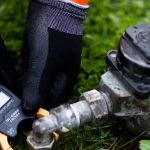How to Save Water & Spot Leaks

Leaking pipes in your home can be more than just a burden, they also can waste more than 40 litres a day and raise your water bill. Below is a list of ways you can help save on your water usage and lower your bill each month.
Checking Pipes and Faucets for Leaks
A faucet with a drip, even a small one can use up to 80 litres of water each day, and the bigger the leak the wasted water can reach over 400 litres per day.
Toilets are Not for Trash
Each time something like facial tissues or small amounts of trash is flushed down the toilet it can be wasting water. Each flush uses 3-18 litres of water.
Checking Toilets for a Leak
You can test for leaks by using food coloring in your toilet. If there is a leak, color will appear in the bowl without flushing. This usually takes about 30 minutes. If you do find a leak, it should be repaired quickly, and it’s usually easy to install the parts and cheap too.
Using Water Meters to Find Hidden Leaks
Every two hours you can read the water meter without using water. If no water is used, but the meter has changed, then you have a leak.
Shower Heads and Faucets That Save Water
By investing in shower heads that have a water saving flow restrictor it can save you on water usage. They tend to be inexpensive and simple to install. Hot showers can use up to 40 litres of water per minute, limiting showers to just enough time needed for washing up will save you too. The low flow heads use about 9 litres a minute.
Aerators should be used on all of the faucets in the house too as it can be the best way to conserve water for the home, and it’s among the cheapest methods.
Plastic Bottles in the Toilet Tank
You can reduce the water waste by putting pebbles or sand in plastic bottles, about one or two inches to create weight. Then, fill the rest of the bottle with water and tighten the lid and place them in the toilet tank. It should be placed away from any mechanisms to avoid damage.
You will want to ensure that at least three gallons of water remains in the tank so that if flushes as it should. Without enough water to flush, it causes the lever to be held longer and multiple flushes may be needed, defeating the purpose. A 7.5 litre flush is still better than two flushes of 5 litres.
When installing new toilets, consider the ‘low flush’ options that only use 1.5-6 litres per flush compared to those that use up to 18 litres. This converts to a 30% reduction of indoor water usage.
After trying some of our DIY leak detection tips, you suspect you have a leak, contact Master Leak Detective.





